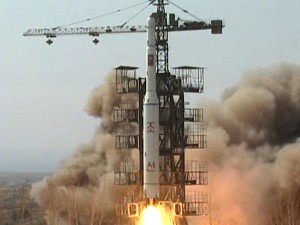North Korea rocket still on launch pad as wary world waits

In this April 5, 2009 image made from KRT video, a rocket is lifted off from its launch pad in Musudan-ri, North Korea. As the US and its allies decry North Korea's planned rocket launch, they're also rushing to capitalize on the rare opportunity it presents to assess the secretive nation's ability to strike beyond its shores. AP
PYONGYANG—North Korea’s first chance at a rocket launch came and went Thursday with no word of a liftoff, but also with no sign that Pyongyang intends to call off what the United States and its allies consider an attempt to test long-range missile technology.
The launch window for what North Korea says is an observation satellite opened during a week aimed at celebrating Sunday’s centennial of the birth of Kim Il-sung, the country’s late founder. Events also include high-level meetings where new leader Kim Jong-un has received at least three new titles to further cement his rule.
North Korea had told international organizations that its rocket launch would come between Thursday and Monday, between 7 a.m. and noon local time. That timeframe passed Thursday without liftoff.
North Korean space officials, who had taken foreign journalists to the launch control center on Wednesday and said fueling was under way, did not comment on the timing of the launch beyond saying it would occur in the five-day window.
Bad weather
Poor weather made a Thursday launch unlikely, Philippine disaster management agency chief Benito Ramos said, citing an assessment passed on to him by the Philippine military, which is being briefed by US and Japan counterparts. Wind in particular can scuttle rocket launches.
The United States, Japan, Britain and others say the launch would constitute a provocation and would violate UN Security Council resolutions banning North Korea from developing its nuclear and missile programs. Experts say the Unha-3 carrier is similar to the type of rocket that could be used to fire a missile mounted with a nuclear warhead to strike the US or other targets.
North Korea denies that the launch is anything but a peaceful civilian bid to send a satellite into space. The Kwangmyongsong-3 satellite is designed to send back images and data that will be used for weather forecasts and agricultural surveys.
Pyongyang made two previous attempts to launch a satellite, in 1998 and 2009, but the United States and other outside observers say there is no evidence that either reached orbit.
This week’s planned launch came with more fanfare, with Pyongyang inviting a possibly unprecedented crowd of foreign journalists and other guests.
Getting into orbit
The Unha-3 rocket has three stages, or parts. If all goes well, the first will burn out and fall in waters off the west coast of South Korea in about two minutes. The second will separate four to six minutes after the launch, then splash down in the Pacific off the northern Philippines. The third will burn up in the atmosphere after boosting the satellite into orbit.
All this will take 10 minutes. The satellite will then enter a near-polar, sun-synchronous orbit, meaning it will pass over the same point on the Earth at about the same time each day. The 500-kilometer (300-mile) altitude announced by the North is considered a low Earth orbit, which is where most artificial satellites go.
Trajectory
Professional and amateur satellite watchers question North Korea’s calculations. They infer from data provided by Pyongyang that the probe will not be able to reach its orbit without conducting difficult navigational maneuvers very soon after liftoff. One expert says the rocket will skirt China’s east coast near Shanghai, fly over Taiwan and shed its second stage into the sea, 50 kilometers (30 miles) off the northern Philippines.
Japan and South Korea say they will shoot down the rocket in the unlikely event it veers off course and heads toward their territory.
The satellite
The minibar refrigerator-sized satellite is covered with solar panels and golden foil to protect its instruments. One-meter (three-feet) tall and weighing 100 kilograms (220 pounds), the “Bright Shining Star 3” is designed to monitor weather, natural disasters and agriculture patterns. Experts say the satellite and its predecessors, Bright Shining Stars 1 and 2, were probably developed with China’s help. It is unlikely the latest version could effectively multitask, since it is so small and North Korea has no demonstrated track record with simpler missions.
Odes from space
Pyongyang says the satellite will broadcast martial music praising North Korea’s founder, Kim Il-sung. It says Bright Shining Stars 1 and 2, launched in 1998 and 2009, did the same. But no broadcasts were ever detected, and neither probe is believed to have reached orbit.
If the broadcasts on the UHF and X-bands are successful, the first independent confirmation could come from western Australia, which might pick them up within 20 minutes. The west coast of South America would be next, followed by the US east coast. North Korea would not likely hear them until as much as 12 hours later.














